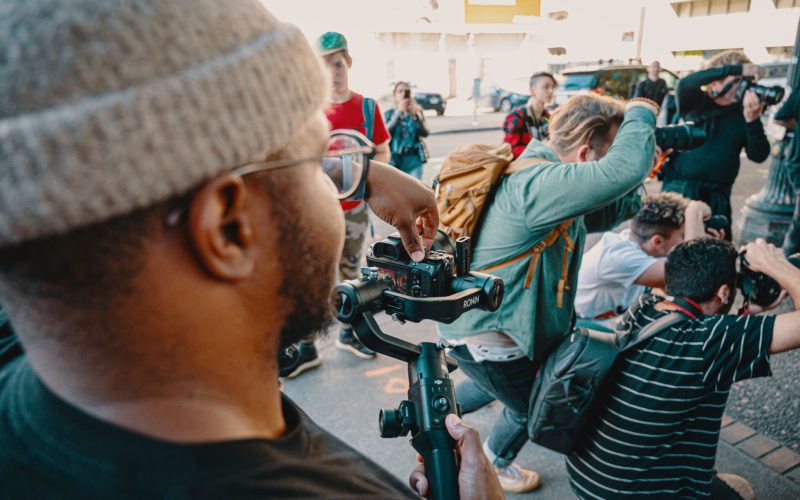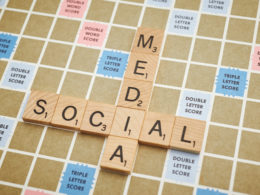Paparazzi and celebrities seem perpetually at war, with celebrities simply trying to avoid harassment, and paparazzi using any means to “get the shot.” With the rise of social media, the two sides are engaged in a new type of battle, with the battleground being celebrity’s Instagram feed, and copyright law as the paparazzi’s weapon of choice.
“Copyright trolling” occurs when a celebrity posts a photo of themself, taken by a paparazzo, onto their Instagram page without paying the photographer a licensing fee.1[1]Austin Joseph, Feeling Cute, Might [Have To] Delete Later: Defending Against the Modern Day Copyright Troll, 27 UNIV. OF GA. J. INTELL. PROP. L. 329, 331 (2020). These photographers often search the internet for unauthorized images posted to social media by celebrities.2[2]Id. The photographers then file a copyright infringement suit in hopes of winning settlement payouts.3[3]Id. From 2017 to May 2020, at least nineteen celebrities were sued, and with the rise of social media these numbers are expected to continue to increase.4[4]Emma Perot, The Conflict Between the Copyright of Paparazzi and the Right of Publicity of Celebrities, 30 Tx. Intell. Prop. L.J. 121 (2021).
Why Do Paparazzi Triumph in these Cases?
Pursuant to § 102(a) of the Copyright Act of 1976, copyright protection exists “in original works of authorship fixed in any tangible medium of expression.”5[5]Copyright Act of 1976, 17 U.S.C. § 102(a) (2021). Although photos captured of celebrities may seem like a stretch for an “original” or “expressive” work, courts generally consider such works to be original due to their “creative choices, including … their lighting, angle, and focus.”6[6]Sands v. CBS Interactive Inc., No. 18-CV-7345, 2019 WL 1447014, at 3 (S.D.N.Y. Mar. 13, 2019). As such, these celebrity photographs fall within the subject matter of copyright protection.7[7]Copyright Act of 1976, 17 U.S.C. § 102(a) (2021).
Although most paparazzi photos are considered original works and thus have copyright protection, in Fourth Est. Pub. Benefit Corp v.Wall-Street.com, LLC, the Supreme Court held that authors must register their work with the U.S. Copyright Office prior to filing a copyright infringement claim.8[8]Fourth Est. Pub. Benefit Corp.v. Wall-Street.com, LLC, 139 S. Ct. 881, 891(2019). Once an author receives the copyright registration for their work, they may bring copyright infringement claims over alleged infringement that occurred prior to the work’s registration.9[9]Id. at *887.
Right of Publicity
A celebrity’s ability to control the commercial exploitation of their fame is recognized in thirty-five states as a “right of publicity.”10[10]Mark Roesler & Garrett Hutchinson, What’s in a Name, Likeness, and Image? The Case for a Federal Right of Publicity Law, AMERICAN BAR ASSOCIATION (Sept. 16, 2020), https://www.americanbar.org/groups/intellectual_property_law/publications/landslide/2020-21/september-october/what-s-in-a-name-likeness-image-case-for-federal-right-of-publicity-law/#6. The right of publicity protects against the misappropriation of one’s “name, likeness, or other indicia of personal identity – such as … photograph -” from commercial exploitation.11[11]International Trademark Association, Right of Publicity, https://wwwinta.org/topics/right-of-publicity/#:~:text=What%20Is%20Right%20of%20Publicity,or%20photograph%E2%80%94for%20commercial%20benefit. Grey’s Anatomy star Katherine Heigl filed suit against drug store Duane Reade in 2014 for violation of her right of publicity when they tweeted photographs of her exiting their store with the text, “Even @KatieHeigl can’t resist shopping #NYC’s favorite drugstore.”12[12]Amy Delauter, Katherine Heigl v. Duane Reade: The Predicted Outcome and Insight into New York Publicity Rights, 34 Cardozo Arts & Ent. L.J. (July, 3 2016). Although the case eventually settled out of court, Heigl claimed her image was being used to endorse Duane Reade’s business through commercial advertising without her consent, and so constituted a violation of her right of publicity.13[13]Id.
Thus far, the right of publicity defense is not widely utilized by celebrities entangled in paparazzi suits over copyright infringement, as most states have a “newsworthy” exception to the right of publicity.14[14]New York Right of Publicity Law, Digital Media Law Project, (Sept. 10, 2022), https://www.dmlp.org/legal-guide/new-york-right-publicity-law#:~:text=Newsworthy%20uses%20of%20a%20person’s,are%20also%20exempt%20from%20liability. In New York, newsworthiness includes any article concerning public interest, regardless of whether it is being used solely to increase the circulation of a publication.15[15]Messenger ex rel. Messenger v. Gruner + Jahr Printing & Pub., 94 N.Y.2d 436, 442, 727 N.E.2d 549, 552 (2000). As public figures, many people consider celebrities’ daily lives to constitute “public affairs,” thus placing personal information and content about celebrities into the “newsworthiness” exception.16[16]Shlomit Yanisky-Ravid, & Ben Zion Lahav, Public Interest vs. Private Lives–Affording Public Figures Privacy in the Digital Era: The Three Principle Filtering Model, 19 U. PA. J. CONST. L. 975 (2017). A further complication involving the right of publicity is that the U.S. Copyright Act is federal law and thus preempts a state’s right of publicity statute.17[17]James M. Chadwick and Roxana Vatanparast, The Copyright Act’s Preemption of Right of Publicity Claims, 25 Communications Lawyer, ABA 25 (July 2008). Under the Supremacy Clause to the U.S. Constitution, federal law trumps state law when the two conflict.18[18]Id. If a paparazzo’s photo is considered an original work of expression, it is protected under the Copyright Act, and a right of publicity claim against it will likely fail.19[19]Id.
Fair Use
The “fair use” defense can also be raised in response to copyright infringement claims, but is limited to certain uses under the Copyright Act.20[20]17 U.S.C. § 107. When evaluating whether an alleged infringement was fair use, courts consider (1) the purpose and character of the use, including where such use is of a commercial nature, (2) the nature of the work, (3) the amount and substantiality of the portion used as related to the work as a whole, and (4) the effect on potential market value.21[21]Id.
Recently, photographer Robert O’Neill sued prominent model and actress Emily Ratajkowski for copyright infringement on a photo O’Neill captured of Ratajkowski walking down the street, with her face covered by a bouquet of flowers.22[22]O’Neil v. Ratajkowski, No. 19 CIV. 9769 (S.D.N.Y. Sep.28, 2021). Ratajkowski subsequently posted the photo on her Instagram story.23[23]Id. In defending the copyright infringement claim, Ratajkowski asserted the fair use defense.24[24]Id. at *123. The court addressed the first fair use factor and found that the placement of the text “mood forever” on the photo could be interpreted by a reasonable observer as a commentary on the invasiveness of paparazzi.25[25]Id. at *129. Therefore, the court considered Ratajkowski’s use of O’Neill’s photo to be transformative in nature.26[26]Id. at *129. The court concluded that there was a genuine issue of fact as to whether or not her use was transformative under the first factor, which could not be determined at summary judgment.27[27]Id. at *139.
The court found that the second factor weighed in favor of O’Neill, as the work was creative in nature and published.28[28]Id. at *131. The court also found the third factor weighed in favor of O’Neill, but only slightly, as even though Ratajkowski used the totality of the image, she placed it on her temporary Instagram story rather than as a more permanent fixture as a post.29[29]Id. at *132. As to the fourth factor, the court stated that Ratajkowski did not provide enough evidence to prove no market harm occurred, despite her argument that the photo was worthless as her face was covered.30[30]Id. at *132. The court was unable to rule on this issue at the summary judgment stage due to lack of information regarding the market for potential profits from paparazzi licensing for social media use.31[31]Id. at *134.
With two factors weighing in O’Neill’s favor and two left undecided due to material issues of fact, O’Neill’s motion for summary judgment was granted in part and denied in part.32[32]Id. at *134. The parties eventually reached a settlement out of court.33[33]Winston Cho, Emily Ratajkowski Lawsuit Over Paparazzi Photo Settles, The Hollywood Reporter (April 13, 2022, 5:52 p.m.), https://www.hollywoodreporter.com/business/business-news/emily-ratajkowski-lawsuit-over-paparazzi-photo-settles-1235130004/. This case leaves open some questions. For instance, what is considered “transformative” in a celebrity’s use of paparazzi photos, and to what extent must one edit a photo posted on social media for it to be considered transformative? Additionally, can a social media post by a celebrity be deemed “commercial use” if they are not directly profiting from the image itself?34[34]O’Neil v. Ratajkowski, No. 19 CIV. 9769, 50 (S.D.N.Y. Sep.28, 2021).
Ultimately, courts are hesitant to recognize fair use as a defense in copyright trolling cases as the outcome of the analysis is dependent on the facts of each circumstance.35[35]U.S. Copyright Fair Use Index (Feb. 2023), https://www.copyright.gov/fair-use/. Different circumstances the courts may consider include whether the post is considered commercial in nature, whether the entire image is posted versus a portion, and if a celebrity’s post causes the potential market value of the image to depreciate, as news outlets and magazines are then less likely to purchase a widely viewed image.36[36]Aaron Deitsch & Dylan DesChamps, Can Celebrities Post Photos Taken by Paparazzi to Their Own Social Media Accounts? ROMANO LAW BLOG (Nov. 24, 2021), https://www.romanolaw.com/2021/11/24/can-celebrities-post-photos-taken-by-paparazzi-to-their-own-social-media-accounts/#:~:text=While%20celebrities%20may%20have%20rights,license%20the%20copyright%20for%20it.
The Latest Defense Arguments Used by Celebrities in Attempts to Tip the Scale
Celebrities, weary of copyright trolls, have ventured into unprecedented legal territory and are seeking ways to avoid paying settlement costs.
Unclean Hands
In California, Backgrid, a paparazzi agency, filed a copyright infringement claim against actress and TV personality Lisa Rinna, best known for her roles on Days of Our Lives and The Real Housewives of Beverly Hills.37[37]Complaint for Copyright Infringement (17 U.S.C. § 501) at 2-3, Backgrid USA, Inc. v. Rinna, No. 2:21-cv-04779-MCS-E (C.D. Cal. Jun. 11, 2021). Backgrid demanded $1.2 million in damages as a result of eight copyrighted photos that Rinna posted to her Instagram.38[38]Id. In response to Backgrid’s complaint, Rinna stated that Backgrid misused copyright law and possessed “unclean hands” due to the way they scour the internet to find potential celebrities to sue.39[39]Michael Hiltzik, Column: Lisa Rinna is Getting Sued for Posting Paparazzi Photos of Herself. Why?, LOS ANGELES TIMES (Oct. 5, 2021, 6:00 a.m.), https://www.latimes.com/business/story/2021-10-05/lisa-rinna-paparazzi-lawsuit. The affirmative defense of “unclean hands” can be used to bar a plaintiff’s claim for equitable relief if the defendant can show that the plaintiff acted unfairly or fraudulently.40[40]Legal Information Institute, Cornell Law School (Sept. 2022), https://www.law.cornell.edu/wex/clean-hands_doctrine. Rinna also alleged that Backgrid anticipated lawsuits as a means to compensate for COVID-19-related revenue losses, and thus, “weaponized” the Copyright Act for personal gain.41[41]Michael Hiltzik, Column: Lisa Rinna is Getting Sued for Posting Paparazzi Photos of Herself. Why?, LOS ANGELES TIMES (Oct. 5, 2021, 6:00 a.m.), https://www.latimes.com/business/story/2021-10-05/lisa-rinna-paparazzi-lawsuit. The “unclean hands” defense is rarely used by celebrities, and there is uncertainty as to how the court will interpret it in future cases.
Implied Licenses
Rinna also raised the defense of an “implied license.”42[42]Defendant Lisa Rinna’s Amended Answer to Complaint at 4, Backgrid USA, Inc. v. Rinna, No. 2:21-cv-04779-MCS-E (C.D. Cal., Oct. 1, 2021). In copyright law, an “implied in fact” license exists when a person creates and delivers a work to another, at their request, with the intent for them to copy and distribute it.43[43]Annemarie Bridy, A Novel Theory of Implied Copyright License in Paparazzi Pics, LAW360 (Aug. 6, 2019, 11:43 a.m.), https://www.law360.com/articles/1185445/a-novel-theory-of-implied-copyright-license-in-paparazzi-pics. However, it is difficult to win using this defense if no written contract exists between the two parties.44[44]Jacqui Lipton, Implied Licenses in Copyright Law, AUTHORS ALLIANCE (May 27, 2020), https://www.authorsalliance.org/2020/05/27/implied-licenses-in-copyright-law/. Although courts sometimes disagree, in many cases they find that there must be intent on behalf of the plaintiff in order for an implied license to exist.45[45]Id.
Rinna argued that any potential profits Backgrid earned from the photos would solely be due to her fame, hard work, and expertise in her craft.46[46]Defendant Lisa Rinna’s Amended Answer to Complaint at 4, Backgrid USA, Inc. v. Rinna, No. 2:21-cv-04779-MCS-E (C.D. Cal., Oct. 1, 2021). Therefore, she argued there was an implied license, and that she should be permitted to use the photo however she chooses.47[47]Id. Ultimately, the parties reached settlement outside of court.48[48]Lindsay Cronin, RHOBH Star Lisa Rinna Settles $1.2 Million Lawsuit With Photo Agency as She Avoids Trial, Reality Blurb (Jun. 23, 2022), https://realityblurb.com/2022/06/23/rhobhs-lisa-rinna-settles-1-2-million-lawsuit-with-photo-agency-as-she-avoids-trial/.
Supermodel Gigi Hadid also raised this defense in a copyright infringement case filed in 2019.49[49]Xclusive-Lee, Inc. v. Hadid, No. 19CV520PKCCLP, 2019 WL 3281013 (E.D.N.Y. Jul. 18, 2019). Hadid argued that she held an implied license to a paparazzi photo posted on her Instagram account because a “meeting of the minds” occurred between the two parties when she stopped and posed for the photo.50[50]Bill Donahue, Celebrities Keep Getting Sued Over Photos of Themselves, LAW360 (Sept. 17, 2020), https://plus.lexis.com/newsstand#/law360/article/1310980. In doing so, she argued, she “contributed to the photograph’s protectable elements.”51[51]Id. The court dismissed the case without reaching a conclusion regarding whether implied license is an appropriate defense.52[52]Id.
Conclusion
With the evolving and pervasive monetization of social media, the frequency of copyright cases brought by paparazzi will likely continue to rise. The more cases that are brought, and in turn the more court decisions that are issued, will provide clarity to celebrities and photographers alike on the issue. Hopefully, courts’ interpretation of creative celebrity defenses will provide more concrete insight as to how the law applies to celebrity-paparazzi copyright cases.
Written by: Delia O’Brien
Delia is a 2023 J.D. Candidate at Brooklyn Law School
1 Austin Joseph, Feeling Cute, Might [Have To] Delete Later: Defending Against the Modern Day Copyright Troll, 27 Univ. of Ga. J. Intell. Prop. L. 329, 331 (2020).04.18.16.pdf.
2 Id.
3 Id.
4 Emma Perot, The Conflict Between the Copyright of Paparazzi and the Right of Publicity of Celebrities, 30 Tx. Intell. Prop. L.J. 121 (2021).
5 Copyright Act of 1976, 17 U.S.C. § 102(a) (2021).
6 Sands v. CBS Interactive Inc., No. 18-CV-7345, 2019 WL 1447014, at 3 (S.D.N.Y. Mar. 13, 2019).
7 Copyright Act of 1976, 17 U.S.C. § 102(a) (2021).
8 Fourth Est. Pub. Benefit Corp.v. Wall-Street.com, LLC, 139 S. Ct. 881, 891(2019).
9 Id. at 887.
10 Mark Roesler & Garrett Hutchinson, What’s in a Name, Likeness, and Image? The Case for a Federal Right of Publicity Law, American Bar Association (Sept. 16, 2020), https://www.americanbar.org/groups/intellectual_property_law/publications/landslide/2020-21/september-october/what-s-in-a-name-likeness-image-case-for-federal-right-of-publicity-law/#6.
11 International Trademark Association, Right of Publicity, https://wwwinta.org/topics/right-of-publicity/#:~:text=What%20Is%20Right%20of%20Publicity,or%20photograph%E2%80%94for%20commercial%20benefit.
12 Amy Delauter, Katherine Heigl v. Duane Reade: The Predicted Outcome and Insight into New York Publicity Rights, 34 Cardozo Arts & Ent. L.J. (July, 3 2016).
13 Id.
14 New York Right of Publicity Law, Digital Media Law Project, (Sept. 10, 2022), https://www.dmlp.org/legal-guide/new-york-right-publicity-law#:~:text=Newsworthy%20uses%20of%20a%20person’s,are%20also%20exempt%20from%20liability.
15 Messenger ex rel. Messenger v. Gruner + Jahr Printing & Pub., 94 N.Y.2d 436, 442, 727 N.E.2d 549, 552 (2000)
16 Shlomit Yanisky-Ravid, & Ben Zion Lahav, Public Interest vs. Private Lives–Affording Public Figures Privacy in the Digital Era: The Three Principle Filtering Model, 19 U. Pa. J. Const. L. 975 (2017).
17 James M. Chadwick and Roxana Vatanparast, The Copyright Act’s Preemption of Right of Publicity Claims, 25 Communications Lawyer, ABA 25 (July 2008).
18 Id.
19 Id.
20 17 U.S.C. § 107.
21 Id.
22 O’Neil v. Ratajkowski, No. 19 CIV. 9769 (S.D.N.Y. Sep.28, 2021).
23 Id.
24 Id. at 123.
25 Id. at 129.
26 Id. at 129.
27 Id. at 139.
28 Id. at 131.
29 Id. at 132.
30 Id. at 132.
31 Id. at 134.
32 Id. at 139.
33 Winston Cho, Emily Ratajkowski Lawsuit Over Paparazzi Photo Settles, The Hollywood Reporter (April 13, 2022, 5:52 p.m.), https://www.hollywoodreporter.com/business/business-news/emily-ratajkowski-lawsuit-over-paparazzi-photo-settles-1235130004/.
34 O’Neil v. Ratajkowski, No. 19 CIV. 9769, 50 (S.D.N.Y. Sep.28, 2021).
35 U.S. Copyright Fair Use Index (Feb. 2023), https://www.copyright.gov/fair-use/.
36 Aaron Deitsch & Dylan DesChamps, Can Celebrities Post Photos Taken by Paparazzi to Their Own Social Media Accounts? ROMANO LAW BLOG (Nov. 24, 2021), https://www.romanolaw.com/2021/11/24/can-celebrities-post-photos-taken-by-paparazzi-to-their-own-social-media-accounts/#:~:text=While%20celebrities%20may%20have%20rights,license%20the%20copyright%20for%20it.
37 Complaint for Copyright Infringement (17 U.S.C. § 501) at 2-3, Backgrid USA, Inc. v. Rinna, No. 2:21-cv-04779-MCS-E (C.D. Cal. Jun. 11, 2021).
38 Id.
39 Michael Hiltzik, Column: Lisa Rinna is Getting Sued for Posting Paparazzi Photos of Herself. Why?, Los Angeles Times (Oct. 5, 2021, 6:00 a.m.), https://www.latimes.com/business/story/2021-10-05/lisa-rinna-paparazzi-lawsuit.
40 Legal Information Institute, Cornell Law School (Sept. 2022), https://www.law.cornell.edu/wex/clean-hands_doctrine.
41 Michael Hiltzik, Column: Lisa Rinna is Getting Sued for Posting Paparazzi Photos of Herself. Why?, Los Angeles Times (Oct. 5, 2021, 6:00 a.m.), https://www.latimes.com/business/story/2021-10-05/lisa-rinna-paparazzi-lawsuit.
42 Defendant Lisa Rinna’s Amended Answer to Complaint at 4, Backgrid USA, Inc. v. Rinna, No. 2:21-cv-04779-MCS-E (C.D. Cal., Oct. 1, 2021).
43 Annemarie Bridy, A Novel Theory of Implied Copyright License in Paparazzi Pics, LAW360 (Aug. 6, 2019, 11:43 a.m.), https://www.law360.com/articles/1185445/a-novel-theory-of-implied-copyright-license-in-paparazzi-pics.
44 Jacqui Lipton, Implied Licenses in Copyright Law, Authors Alliance (May 27, 2020), https://www.authorsalliance.org/2020/05/27/implied-licenses-in-copyright-law/.
45 Id.
46 Defendant Lisa Rinna’s Amended Answer to Complaint at 4, Backgrid USA, Inc. v. Rinna, No. 2:21-cv-04779-MCS-E (C.D. Cal., Oct. 1, 2021).
47 Id.
48 Lindsay Cronin, RHOBH Star Lisa Rinna Settles $1.2 Million Lawsuit With Photo Agency as She Avoids Trial, Reality Blurb (Jun. 23, 2022), https://realityblurb.com/2022/06/23/rhobhs-lisa-rinna-settles-1-2-million-lawsuit-with-photo-agency-as-she-avoids-trial/.
49 Xclusive-Lee, Inc. v. Hadid, No. 19CV520PKCCLP, 2019 WL 3281013 (E.D.N.Y. Jul. 18, 2019).
50 Bill Donahue, Celebrities Keep Getting Sued Over Photos of Themselves, Law360 (Sept. 17, 2020), https://plus.lexis.com/newsstand#/law360/article/1310980.
51 Id.
52 Id.




